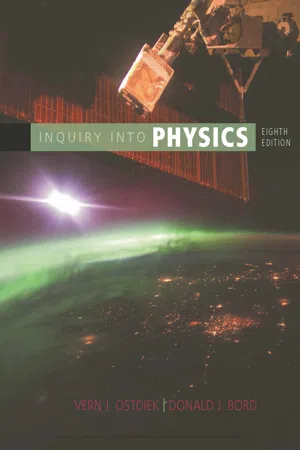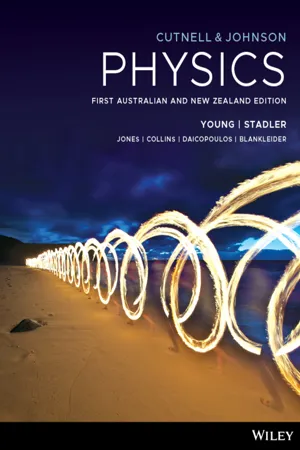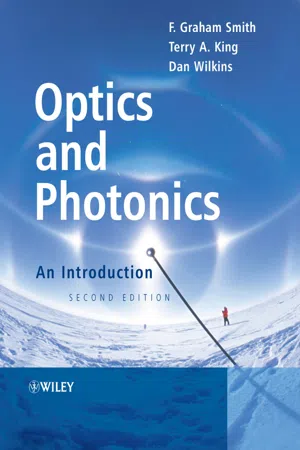Physics
Convex Mirrors
Convex mirrors are curved mirrors where the reflective surface bulges outwards. They diverge light rays, causing the reflected image to appear smaller and upright. These mirrors are commonly used in security mirrors, side-view mirrors in vehicles, and in certain optical devices where a wide field of view is required.
Written by Perlego with AI-assistance
Related key terms
1 of 5
8 Key excerpts on "Convex Mirrors"
- eBook - PDF
- Vern Ostdiek, Donald Bord(Authors)
- 2017(Publication Date)
- Cengage Learning EMEA(Publisher)
Magnifying makeup and shaving mirrors are concave mirrors, as are the large mirrors used in astronomical telescopes. Figure 9.22b shows a magnified image seen in a concave mirror. A convex mirror is one that is curved outward. The image formed by a con - vex mirror is reduced—it is smaller than the image formed by a plane mirror d d (Figureuni00A09.22c). The advantage of a convex mirror is that it has a wide field of view—images of things spread over a wide area can be viewed in it. Figure 9.23 shows the fields of view for a convex mirror and a plane mirror of the same size. One glance at a well-placed convex mirror on a bike path allows quick surveillance of a large area (Figure 9.24). Passenger-side rearview mirrors on cars and auxiliary “wide-angle” rearview mirrors on trucks and other vehicles are convex so the driver can view a large region to the rear. Care must be taken when using such a mirror because the reduced image makes any object appear to be farther away than it actually is. uni25D7 Physics To Go 9.7 A shiny metal spoon can serve as either a concave mirror or a convex mirror, although its shape is usually far from ideal. The front side of the spoon is a concave mirror. Place your finger close to the spoon and look at its image in the spoon. Describe what you see. Now hold the same side of the spoon a comfortable distance in front of your face. What is different about the image of your face that you see? The back side of a spoon is a convex mirror. Describe the image of your face and surrounding environment seen in this side of the spoon. Concave mirror Normal Focal point (a) Figure 9.21 (a) Parallel rays reflecting off a concave mirror converge to a point called the focal point. (The normal for the upper ray shows that the law of reflection applies.) (b) Sunlight focused by a concave mirror can generate high temperatures. This piece of wood was in flames a few seconds after being placed at the mirror’s focal point. - eBook - PDF
- Fatih Gozuacik, Denise Pattison, Catherine Tabor(Authors)
- 2020(Publication Date)
- Openstax(Publisher)
For any object placed on the far side of the focal point with respect to the mirror, the rays converge in front of the mirror to form a real image, which can be projected onto a surface, such as a screen or sheet of paper However, for an object located inside the focal point with respect to the concave mirror, the image is virtual. For a convex mirror the image is always virtual—that is, it appears to be behind the mirror. The ray diagrams in Figure 16.10 show how to determine the nature of the image formed by concave and Convex Mirrors. Figure 16.10 (a) The image of an object placed outside the focal point of a concave mirror is inverted and real. (b) The image of an object 482 Chapter 16 • Mirrors and Lenses Access for free at openstax.org. placed inside the focal point of a concave mirror is erect and virtual. (c) The image of an object formed by a convex mirror is erect and virtual. The information in Figure 16.10 is summarized in Table 16.1 . Type of Mirror Object to Mirror Distance, d o Image Characteristics Concave Real and inverted Concave Virtual and erect Convex Virtual and erect Table 16.1 Curved Mirror Images This table details the type and orientation of images formed by concave and Convex Mirrors. WATCH PHYSICS Parabolic Mirrors and Real Images This video uses ray diagrams to show the special feature of parabolic mirrors that makes them ideal for either projecting light energy in parallel rays, with the source being at the focal point of the parabola, or for collecting at the focal point light energy from a distant source. Click to view content (https://www.openstax.org/l/28Parabolic) Explain why using a parabolic mirror for a car headlight throws much more light on the highway than a flat mirror. a. The rays do not polarize after reflection. b. The rays are dispersed after reflection. c. The rays are polarized after reflection. d. The rays become parallel after reflection. You should be able to notice everyday applications of curved mirrors. - eBook - PDF
- John D. Cutnell, Kenneth W. Johnson, David Young, Shane Stadler(Authors)
- 2015(Publication Date)
- Wiley(Publisher)
Thus, the outside mirror on the passenger side is often a convex mirror. Printed on such a mirror is usually the warning “VEHICLES IN MIRROR ARE CLOSER THAN THEY APPEAR.” The reason for the warning is that, as in Figure 25.21a, the virtual image is reduced in size and therefore looks smaller, just as a distant object would appear in a plane mirror. An unwary driver, thinking that the side-view mirror is a plane mirror, might incorrectly deduce from the small size of the image that the car behind is far enough away to ignore. Because of their wide field of view, Convex Mirrors are also used in stores for security purposes. (b) McPHOTO/Age Fotostock 710 Chapter 25 | The Reflection of Light: Mirrors 25.6 | The Mirror Equation and the Magnification Equation Ray diagrams drawn to scale are useful for determining the location and size of the image formed by a mirror. However, for an accurate description of the image, a more analytical technique is needed, so we will derive two equations, known as the mirror equation and the magnification equation. These equations are based on the law of reflection and provide relationships between: f 5 the focal length of the mirror d o 5 the object distance, which is the distance between the object and the mirror d i 5 the image distance, which is the distance between the image and the mirror m 5 the magnification of the mirror, which is the ratio of the height of the image to the height of the object. Concave Mirrors We begin our derivation of the mirror equation by referring to Figure 25.22a, which shows a ray leaving the top of the object and striking a concave mirror at the point where the principal axis intersects the mirror. Since the principal axis is perpendicular to the mirror, it is also the normal at this point of incidence. Therefore, the ray reflects at an equal angle and passes through the image. - eBook - PDF
- John D. Cutnell, Kenneth W. Johnson, David Young, Shane Stadler(Authors)
- 2021(Publication Date)
- Wiley(Publisher)
This ray is initially parallel to the principal axis and, therefore, appears to originate from the focal point F after reflection from the mirror. Ray 2. This ray heads toward F, emerging parallel to the principal axis after reflection. Ray 2 is analogous to ray 1, except that the reflected, rather than the incident, ray is parallel to the principal axis. Ray 3. This ray travels toward the center of curvature C; as a result, the ray strikes the mirror perpendicularly and reflects back on itself. The three rays in Interactive Figure 25.21a appear to come from a point on a virtual image that is behind the mirror. The virtual image is diminished in size and upright, relative to the object. A convex mirror always forms a virtual image of the object, no matter where in front of the mirror the object is placed. Interactive Figure 25.21b shows an example of such an image. INTERACTIVE FIGURE 25.21 (a) An object placed in front of a convex mirror always produces a virtual image behind the mirror; the image is reduced in size and is upright. (b) The skier’s chromed helmet acts as a convex mirror and produces an image of the spectators who are watching the event. (a) (b) 3 1 2 C F Object Virtual image Popperfoto/Getty Images 25.6 The Mirror Equation and the Magnification Equation 799 THE PHYSICS OF . . . passenger-side automobile mirrors. Because of its shape, a convex mirror gives a wider field of view than do other types of mirrors. A mirror with a wide field of view is needed to give a driver a good rear view. Thus, the outside mirror on the passenger side is often a convex mirror. Printed on such a mirror is usually the warning “objects in mirror are closer than they appear.” The reason for the warning is that, as in Interactive Figure 25.21a, the virtual image is reduced in size and therefore looks smaller, just as a distant object would appear in a plane mirror. - No longer available |Learn more
Physics for Scientists and Engineers
Foundations and Connections, Extended Version with Modern Physics
- Debora Katz(Author)
- 2016(Publication Date)
- Cengage Learning EMEA(Publisher)
The inner rays focus at a single point, but the outer rays focus at another point closer to the mirror. B. The rays reflected by a convex mirror appear to come from points behind the mirror. The inner rays appear to originate from one point, but the outer rays appear to originate from another point, closer to the mirror. A. Concave mirror C Front B. Convex mirror Back Optical axis C Front Back Optical axis FIGURE 37.42 All rays focus at a single point for a parabolic mirror. Copyright 2017 Cengage Learning. All Rights Reserved. May not be copied, scanned, or duplicated, in whole or in part. WCN 02-300 1212 CHAPTER 37 Reflection and Images Formed by Reflection SUMMARY The problem was corrected by the addition of other optical systems. Once the actual shape of the primary mirror was measured, engineers designed a system of mirrors called COSTAR (corrective optics space telescope axial replacement) to correct the problem. This system is like the corrective lenses given to a nearsighted person. COSTAR was installed in December 1993. Figure 37.13 shows that COSTAR was successful. There is an important lesson in this story: People make mistakes, but they can also correct those mistakes. Since 1993, the HST has contributed to major discoveries in our understanding of the Universe. ! Underlying Principles Geometric optics: When light encounters only obstacles and apertures that are at least 1 mm in diameter, the ray model is valid. According to this model, light travels in straight lines represented by rays. The ray model ignores the wave properties of light. ★ Major Concepts 1. According to the law of reflection, the angle of inci- dence equals the angle of reflection: u i 5 u r (37.3) The incident ray, the reflected ray, and the perpen- dicular (normal) line all lie in a single plane, called the plane of incidence (Fig. 37.7). - Raymond Serway, John Jewett(Authors)
- 2018(Publication Date)
- Cengage Learning EMEA(Publisher)
In a convex mirror, the image of an object is always virtual, upright, and reduced in size as shown in Figure 35.13c. In this case, as the object distance decreases, the virtual image increases in size and moves away from the focal point toward the mir- ror as the object approaches the mirror. You should construct other diagrams to verify how image position varies with object position. Q UICK QUIZ 35.2 You wish to start a fire by reflecting sunlight from a mirror onto some paper under a pile of wood. Which would be the best choice for the type of mirror? (a) flat (b) concave (c) convex Q UICK QUIZ 35.3 Consider the image in the mirror in Figure 35.14. Based on the appearance of this image, would you conclude that (a) the mirror is concave and the image is real, (b) the mirror is concave and the image is virtual, (c) the mirror is convex and the image is real, or (d) the mirror is convex and the image is virtual? Figure 35.14 (Quick Quiz 35.3) What type of mirror is shown here? Example 35.3 The Image Formed by a Concave Mirror A spherical mirror has a focal length of 1 10.0 cm. (A) Locate and describe the image for an object distance of 25.0 cm. S O L U T I O N Conceptualize Because the focal length of the mirror is positive, it is a concave mirror (see Table 35.1). We expect the possi- bilities of both real and virtual images. continued PITFALL PREVENTION 35.4 Choose a Small Number of Rays A huge number of light rays leave each point on an object (and pass through each point on an image). In a ray diagram, which displays the characteristics of the image, we choose only a few rays that fol- low simply stated rules. Locating the image by calculation comple- ments the diagram. NASA Copyright 2019 Cengage Learning. All Rights Reserved. May not be copied, scanned, or duplicated, in whole or in part. Due to electronic rights, some third party content may be suppressed from the eBook and/or eChapter(s).- eBook - PDF
- John D. Cutnell, Kenneth W. Johnson, David Young, Shane Stadler, Heath Jones, Matthew Collins, John Daicopoulos, Boris Blankleider(Authors)
- 2020(Publication Date)
- Wiley(Publisher)
Notice the lamp adjacent to the patient’s head above her right shoulder. Source: Robert Kneschke / Alamy Stock Photo Source: Dmitry Kalinovsky / Shutterstock 720 Physics CONCEPT SUMMARY 25.1 Relate wave fronts and rays. Wave fronts are surfaces on which all points of a wave are in the same phase of motion. Waves whose wave fronts are flat surfaces are known as plane waves. Rays are lines that are perpendicular to the wave fronts and point in the direction of the velocity of the wave. 25.2 Apply the law of reflection to plane mirrors. When light reflects from a smooth surface, the reflected light obeys the law of reflection: The incident ray, the reflected ray, and the normal to the surface all lie in the same plane, and the angle of reflection r equals the angle of incidence i ( r = i ). 25.3 Describe image formation by a plane mirror. A virtual image is one from which all the rays of light do not actually come, but only appear to do so. A real image is one from which all the rays of light actually do emanate. A plane mirror forms an upright, virtual image that is located as far behind the mirror as the object is in front of it. In addition, the heights of the image and the object are equal. 25.4 Calculate the focal length of a spherical mirror. A spherical mirror has the shape of a section from the surface of a hollow sphere. If the inside surface of the mirror is polished, it is a concave mirror. If the outside surface is polished, it is a convex mirror. The principal axis of a mirror is a straight line drawn through the centre of curvature and the middle of the mirror’s surface. Rays that are close to the principal axis are known as paraxial rays. Paraxial rays are not necessarily parallel to the principal axis. The radius of curvature R of a mirror is the distance from the centre of curvature to the mirror. The focal point of a concave spherical mirror is a point on the principal axis, in front of the mirror. - eBook - PDF
Optics and Photonics
An Introduction
- F. Graham Smith, Terry A. King, Dan Wilkins(Authors)
- 2007(Publication Date)
- Wiley(Publisher)
Close to the mirror one sees a normal image, not much different from that in a plane mirror; outside the centre of curvature one sees an image not far behind the mirror, reduced in size and inverted. Example. A shaving mirror has a concave surface on one side with a radius of curvature of 40 cm, and a plane mirror on the other side. When looking at oneself imaged in the plane side, how far from the mirror should one’s face be for the image to be 30 cm away from the real face? The mirror equation is 1 = v 1 = u ¼ 2 = r ¼ 2 = 1 ¼ 0, hence v ¼ u and one’s face must be at u ¼ 15 cm. Now repeat for the concave side of the mirror. You may ignore any real images. Solution. We want our real face ( u < 0) to form a virtual image ( v < 0). This means u þ v ¼ 0 : 3 m, and the mirror equation is 1 = v 1 = u ¼ 2 = ð 0 : 4 Þ ¼ 5 m 1 . This gives v ¼ u = ð 5 u þ 1 Þ . Substituting this into v þ u ¼ 0 : 3 gives u 2 þ 0 : 7 u þ 0 : 06 ¼ 0. This has two roots u ¼ 0 : 6 ; 0 : 1. The first of these yields v ¼ 0 : 3, i.e. a positive value indicating a real image. The other root u ¼ 0 : 1 yields v ¼ 0 : 1 = ð 1 5 0 : 1 Þ ¼ 0 : 2. We must therefore put our face 10 cm from the mirror to see its image 20 cm behind the mirror. Note that we get a real image, v ¼ u = ð 5 u þ 1 Þ > 0, whenever our real object is more than the focal length from our mirror (or u < ð 1 = 5 Þ in this case). This is a general property of mirrors and thin lenses that converge. Figure 2.6 A concave spherical mirror: (a) action of the mirror on a wavefront; (b) the geometry of a paraxial ray 2.5 Imaging in Spherical Mirrors 27 2.6 General Properties of Imaging Systems It is remarkable how well simple optical systems can work, despite the approximations that we have made in the lens theory. Even if the object point is at some distance from the axis of a simple lens, rays still converge on an off-axis image point found from the lens equation.
Index pages curate the most relevant extracts from our library of academic textbooks. They’ve been created using an in-house natural language model (NLM), each adding context and meaning to key research topics.







